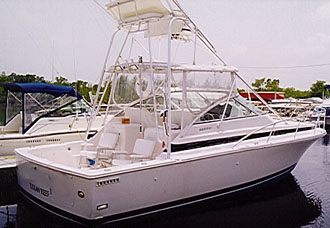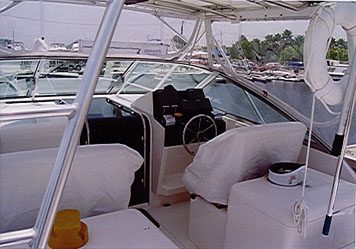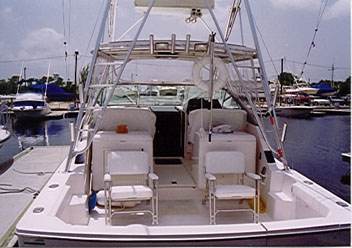Bertram 36 Moppie
1995
by David Pascoe
They say Bertram is still in business after having been acquired by an Italian outfit that seems to have done less than a spectacular job in letting anyone know that Bertram Yacht is still with us. In fact, every time I drive by the plant and glance at the parking lot, I notice its nearly empty, the place is overgrown with weeds, with not much activity going on. Then I go to the Bertram web site and there's almost nothing there. Hello, anyone home?
One thing I do know is that some of the old crew are still hanging around. Bertram went under in 1990 with the recession, but in 93 I was hired by a Japanese Corporation who'd cut a deal with Diaship to begin production on a new line of 46' sport fishermen that were going to be marketed under the Diaship name which, as far as I know, is a Dutch outfit. What the Japanese and Dutch had to do with it, I never quite found out, but the Japs ended up with all six of first and only Diaship 46's produced out of the Bertram plant. My only point with all this is that with a skeleton crew, six superb new boats were turned out. I Q.C'd all six of them and they didn't miss a beat.
Despite what looks to be a closed down operation, a few Bertrams are still rolling out, or so they say, but they are now only offering 54 and 60 convertibles. No more small boats. The problem, I think, is that the demand for "affordable" boats has driven the quality builders right out of the small boat market. The problem is that people want their boats to be like luxury hotel rooms complete with all the amenities, and there's just no way a builder can give them that, and good quality too. At $1,000/ft for a 36 footer, there's just no way to sell enough to keep a production line going. The only way you can get good quality at a lower price is to cut back on all that fanciness. Instead, people are willing to accept cheap luxury at a still outrageous price. What we got here is good quality at a price that will button your pocket flaps down.
This is the first one of its kind that I have seen, no doubt because there aren't many of them, and it may well be the last. There is also supposed to be a new 30' Moppie, but I've never seen one. Yet walking down the dock, this is an eye catcher, not only because it retains those design and style features that shout "Bertram," but also because we haven't seen a style like this before. Sounds like a contradiction, I know, but I had it pegged as a Bertram long before I saw the name on the side. Closest we've seen is the old 38 Special, which is a much larger boat, despite the 2 foot difference.


The next question to pop in my mind was "how big is this thing?" I thought it looked like a 30 footer. Viewed from astern, it looks a lot smaller than 36 feet, but in profile she almost looks her size. Almost. A lot of that has to do with the 13" beam and the rather high aspect for a 36 foot boat. Then you notice that there is an awful lot crammed into that space. Looking at the forward portion of the cockpit deck, which raised up quite high, you also know that this was done to get some rather large diesels in their, the high profile, long stroke, in-line Cat 3116's to be exact. No short stroke, 90 lb. weaklings here, folks. Big tall chunks of cast iron that need a lot of space. Take a gander at the photos and you'll see how they got the space that was needed. With 600 hp in a 36' open hull, I needn't tell you that speed is not a problem here.
The first word to pop into my mind was "nifty." I like it. Whoever designed it managed to get all that stuff in there without making it look like a pile of rubble. You can see right off that while there's not a whole lot of room in the cockpit, the traffic pattern is good enough to allow you to move around freely, although to be sure, four people back there are going to be bumping into each other, at least there's nothing to trip or fall over.
As a trained designer, I know how difficult it is to pull off a design like this. Most small boats with such a high profile usually end up looking a scaled down motel room designed to resemble a boat, what I call the floating campers. You know the kind with the ballooned out decks that look like a bomb set off inside a steel fuel tank. Bloated. Well, there is something of a bloated look to it in profile, yet it still manages to look stylistically good. The semblance of harmonious, graceful lines are there. This is conventional style carried to the limits of good taste. Yet it is unmistakably Bertram.
In fact, that raised deck seems so high its almost like a flybridge. While at first I didn't like that big step up, one quickly comes to appreciate the altitude after getting underway. Yes, sooner or later someone is going to inadvertently take an unfortunate step backwards and end up in a heap in the cockpit, particularly with the lack of hand holds between the bait and tackle centers. There ought to be a couple of sturdy stainless grab rails here. One thing that needs some help here is that 18" wheel which should be 24". It really felt puny in my hands. Then, see those steps molded into the sides of the cockpit? I tripped over them at least three times because you don't expect them to be there. You have a foot cove all around except for there, and as you're moving around, those boxes get you every time. Bad idea.

What I really wanted to know was how she was built. I recently did a late model 35 Tiara Tournament fisherman with which I was appalled at how little glass there was in the hull sides and decks. When I hit the hull sides with my fist, the whole thing would shudder and rattle. At the cut outs for the vents, I could measure the glass thickness at a measly 3/16" thick. Geez, that's what you get for a quarter mil? I mean, is glass and resin that expensive that that's the best they can do? Well, no, it isn't, but there you have it. Bean counters.
The decks sounded thin an tinny, sort of like a drum skin stretched too tight. Wow. I thought, a quarter million bucks and the thing sounds like a rattle trap. For that kind of money they can't even stiffen up the hull sides and put some glass in the decks? Well, I didn't find any of that on the 36 Moppie. I pounded, hammered and even jumped on the decks with no impression of weakness at all. When I jumped on the deck of the Tiara, the overhead cabinet attached to the underside of the deck in the galley area split open! Yes, the decks give that much.
Wow, what a difference, although there's not much difference in price, adjusted for size. Here were two boats, the Bertram weighed in at 20,500 lbs. and the Tiara at 16,000 lbs. Not hard to see where some of the weight difference is. The Bertram was just all-over solid, from the very wide cockpit gunwales to the trunk cabin top which doesn't give when you stomp on it.
A lot of builders are now turning to the vacuum bagging process in an effort to make molded parts as strong as possible. So they say. What they don't say is that it is also an effort to use as little material as possible, squeezing out every last drop of resin possible so that they use less. While the parts may be strong and light, this is also having the effect of creating parts that are thin and thin sounding. The parts are too thin and many of these boats are becoming rattletraps, with acoustics that are just terrible. Honest to God, riding along at high speed in that Tiarra, in barely more than a one foot chop, I went down into the cabin. With the cabin sole and nearly everything else on the interior attached to the bottom of the hull, that boat sounded like it was breaking apart. It wasn't, but the snap, crackle and pop noises it made was downright unnerving. And a lot of that energy was being transmitted right up through all those thin hull structures into the decks you are standing on. You could feel every wave in your feet. The noise was truly awful because these high density, thin laminates ARE just like drum skins stretched too tight.
Well, none of that on our Bertram. The acoustics were just what I'd expect with a well built, conventionally laminated hull and deck. In the cabin, the hull noise level was probably less than half that of the Tiara. No Tin Lizzie rattletrap, this boat. The cabin sole wasn't attached to the bottom of the hull either.
Yes, there are some things to complain about. Like the aluminum bow railings. One of my recent customers was the owner of a foundry. A stainless steel casting foundry, to be exact. In case you're not aware of this, the cost of stainless is going through the roof recently because of a scarcity of nickel. Hence aluminum railings. But its also got aluminum rub rails, cheap, crappy little things which, on this boat is just inexcusable. The very same that Chris Craft used on their Catalina series boats years ago. Junk. Terrible. Awful. Piss you off no end what will happen to them when they rub against a piling.
The engine compartment? Well, as you'd expect there isn't enough room. But at least there is a decent space between the engines, which is greatly reduced by the 8 kw Kohler generator. While you can get down there okay, all you can reach is that which is touching your elbows. Front, back and outboard sides are unreachable. And of course those heavy seating modules mean that owners aren't going to pull the hatches to inspect what needs to be inspected, and repair what needs repairing before things get out of hand. Just isn't going to happen. As these boats grow older, the engine compartments aren't going to age gracefully.
Whatever changes the new ownership has made, they're not showing up much in this boat. If I didn't know the history of the company, I wouldn't suspect that anything had happened. I guess that a lot of that is due to whatever former employees have been retained. They had people down there been with them 30 years, and getting them to change their ways would probably be like trying to walk a cat. When I look at the detail work, I don't see much of anything different.
Its all typically Bertram. At 20,500 lbs this is a heavy boat. Frankly, I've had my fill of light boats and I detest the way they perform in a sea way. And just as importantly, I don't like tinny sounding boats. You know, there's no way they could build and sell a luxury automobile that didn't sound as solid as a rock. Rolls Royce, Mercedes, even Cadillac, go out of their way to make their cars sound solid, whether they are or not.. And people buy them because of that, even if they do have plastic bumpers. Let those cars start sounding thin and cheap and tinny and the show's over. Whether we realize it or not, top quality has a certain sound to it.
I ended up being seduced by this boat because it looked, felt and handled like a top quality boat. All the aesthetic values are there, adding up to a boat that is a real delight to operate. It just feels good. What else can I say?
With only two years of production, its just too bad there won't be more of them around. While I do wish I could give this one a best buy rating, its far too pricey for that. The only other one on the market is asking $339,000, and one suspects it isn't going to sell anytime soon.
Posted July 29, 1998
 Visit davidpascoe.com for his power boat books
Visit davidpascoe.com for his power boat books 














David Pascoe is a second generation marine surveyor in his family who began his surveying career at age 16 as an apprentice in 1965 as the era of wooden boats was drawing to a close.
Certified by the National Association of Marine Surveyors in 1972, he has conducted over 5,000 pre purchase surveys in addition to having conducted hundreds of boating accident investigations, including fires, sinkings, hull failures and machinery failure analysis.
Over forty years of knowledge and experience are brought to bear in following books. David Pascoe is the author of:
In addition to readers in the United States, boaters and boat industry professionals worldwide from nearly 80 countries have purchased David Pascoe's books, since introduction of his first book in 2001.
In 2012, David Pascoe has retired from marine surveying business at age 65.
On November 23rd, 2018, David Pascoe has passed away at age 71.
Biography - Long version